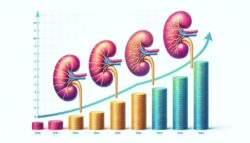Forever Chemicals Linked to Cancer Risk
In recent years, the scientific and medical communities have turned their attention to a group of synthetic chemicals known as per- and polyfluoroalkyl substances (PFAS), which have been dubbed 'Forever Chemicals' due to their persistence in the environment and the human body.

These substances, commonly found in a wide array of consumer products and industrial applications, have become ubiquitous, leading to almost universal exposure. A growing corpus of research suggests that such exposure may be linked to an increased risk of several types of cancer, a possibility that carries profound implications for public health.
Detailed investigations into the mechanisms by which PFAS might influence carcinogenesis are ongoing, but preliminary findings indicate that the stakes may be high. The potential for these chemicals to disrupt delicate hormonal balances, interfere with immune responses, and induce cellular damage presents a complex puzzle for researchers.
As evidence mounts and regulatory agencies grapple with the implications, the question remains: how will society respond to the challenge posed by these seemingly indelible compounds, and what measures can be taken to mitigate their impact on human health?
Understanding 'Forever Chemicals'

Perfluoroalkyl and polyfluoroalkyl substances (PFAS), commonly referred to as 'Forever Chemicals,' are a group of man-made chemicals notorious for their persistence in the environment and human body, raising concerns about their potential health impacts. These substances have been used extensively in various industries due to their unique properties, such as resistance to heat, water, and oil.
PFAS can be found in a wide array of consumer products, including non-stick cookware, food packaging, stain repellents, and firefighting foams. The robustness that makes PFAS valuable in manufacturing also means they do not break down easily, leading to their accumulation in the environment. Consequently, they have become ubiquitous, with detectable levels found in soil, water, wildlife, and human blood serum.
Kidney Cancer and PFAS

Building on the understanding of the pervasive nature of PFAS, recent studies have scrutinized their potential link to increased risks of kidney cancer.
Research indicates that individuals with higher serum concentrations of perfluorooctanoic acid (PFOA) may face greater incidence and mortality rates related to kidney cancer.
Epidemiological investigations, including a nested case-control study, have examined the association between renal cell carcinoma (RCC) and levels of PFOA and other PFAS compounds.
Findings suggest that exposure to these substances could be correlated with the development of kidney cancer.
The implications of these studies are critical, as they suggest a need for stringent regulatory measures on PFAS usage and heightened surveillance of affected populations to mitigate cancer risk.
PFAS: Renal Cell Carcinoma Link

The link between renal cell carcinoma (RCC) and exposure to perfluoroalkyl substances (PFAS) has garnered increasing attention due to emerging research findings that suggest a potential risk increase for this form of kidney cancer in individuals with high serum levels of these chemicals.
Epidemiological studies have reported associations between PFAS exposure and an elevated risk of RCC. Notably, a nested case-control study indicated that individuals with higher concentrations of certain PFAS, particularly perfluorooctanoic acid (PFOA), in their blood may face a greater likelihood of developing RCC.
These findings underscore the importance of continued research to elucidate the mechanisms underlying the carcinogenic potential of PFAS and to inform regulatory actions aimed at reducing human exposure to these persistent environmental contaminants.
Testicular Cancer Connections

While the association between PFAS exposure and renal cell carcinoma has become increasingly recognized, similar concerns have been raised regarding the connection between these chemicals and the risk of testicular cancer.
Research focusing on U.S. Air Force servicemen has linked PFAS exposure, particularly from firefighting foams used at airports and military installations, to an elevated risk of developing testicular cancer.
Investigations into the Department of Defense Serum Repository revealed that higher blood levels of PFOS are associated with a greater incidence of this malignancy.
These findings underscore the need for rigorous scrutiny of the health impacts of PFAS, especially for individuals with occupational exposure to these substances, which persist in the environment and bioaccumulate in human tissues.
Military Exposure to PFAS

Military personnel, frequently exposed to PFAS through the use of firefighting foams and contaminated water supplies, face heightened health risks associated with these persistent environmental pollutants.
The extensive use of aqueous film-forming foams (AFFFs), which contain high levels of PFAS, has been a standard practice for firefighting and training within military installations. Studies reveal that such exposure may correlate with increased incidences of various cancers, including kidney and testicular cancers.
Additionally, military bases often report elevated PFAS concentrations in their water systems, posing a long-term risk to service members and their families.
As a result, the military community is urging for comprehensive investigations and actions to address the potential health implications of PFAS exposure and to implement measures that ensure safer living and working conditions for military personnel.
Firefighting Foam and PFAS

Aqueous film-forming foams (AFFFs), commonly used in firefighting, have become a major source of environmental contamination due to their high per- and poly-fluoroalkyl substances (PFAS) content. These chemicals, renowned for their fire-suppressing properties, are also linked to an array of health risks, including cancer.
PFAS are persistent in the environment and bioaccumulative in human and animal tissues, leading to concerns about long-term exposure. The use of AFFFs in military and civilian firefighting exercises has resulted in PFAS entering water supplies, soil, and ecosystems.
Subsequent research indicates that individuals with occupational exposure to these foams, such as firefighters, may face increased risks for certain cancers, underscoring the urgency for safer alternatives and remediation strategies to mitigate this public health concern.
PFAS and Testicular Cancer Risk

Emerging evidence suggests a troubling link between exposure to per- and polyfluoroalkyl substances (PFAS) and an increased risk of testicular cancer among U.S. Air Force servicemen. These chemicals, commonly found in firefighting foams used at military installations, have been detected at elevated levels in the blood of individuals serving as firefighters or stationed at bases with substantial PFAS water contamination.
Notably, studies within the Department of Defense Serum Repository indicate that higher blood concentrations of PFOS are correlated with a greater likelihood of developing testicular cancer. This association underscores the importance of ongoing research to comprehend the full implications of PFAS exposure on servicemen's health, and to identify necessary measures to mitigate these risks.
PFOS, PFOA, and Breast Cancer

Several studies have explored the potential link between serum concentrations of perfluorooctane sulfonate (PFOS) and perfluorooctanoic acid (PFOA) and the risk of developing postmenopausal breast cancer.
These substances, part of a larger group of chemicals known as per- and polyfluoroalkyl substances (PFAS), have been widely used for their oil and water-repellent properties but are increasingly scrutinized for their potential health impacts.
Recent research, including nested case-control studies, suggests a positive association between pre-diagnostic serum PFOS concentrations and hormone receptor-positive tumor subtypes in postmenopausal women.
However, evidence remains limited and inconclusive, with studies showing differential associations of PFOS and PFOA with breast cancer subtypes.
Continued research is essential to clarify these potential relationships and inform public health strategies.
Hormone Receptor Status Factors

Understanding the role of hormone receptor status is crucial in assessing the risk of breast cancer associated with exposure to PFAS. Differential associations have been observed concerning estrogen receptor (ER) and progesterone receptor (PR) positive tumor subtypes. Epidemiological studies suggest that pre-diagnostic serum concentrations of PFOS and PFOA may be positively associated with the development of ER+ and PR+ breast cancers in postmenopausal women. This association underscores the potential endocrine-disrupting properties of PFAS, which might influence the hormonal milieu and thereby modulate cancer risk.
Consequently, hormone receptor status factors into the risk assessment for breast cancer when considering the impact of PFAS exposure. Ongoing research is imperative to further elucidate these associations and guide public health interventions.
Ovarian Cancer PFAS Research

Building on the insights into hormone receptor status and breast cancer, researchers are now examining the potential link between PFAS exposure and the risk of ovarian cancer. Given the endocrine-disrupting and estrogenic properties of PFAS, there is a plausible biological mechanism through which these substances might influence the development of ovarian and endometrial cancers.
However, the epidemiologic evidence regarding their association remains limited. Ongoing Office of Epidemiology and Environmental Biology (OEEB) research is focusing on elucidating this relationship, emphasizing the necessity for comprehensive investigations.
The current research underscores the importance of evaluating PFAS exposures in diverse populations to better understand the potential health implications and to inform risk assessments and regulatory decisions for ovarian cancer.
Endometrial Cancer and PFAS Exposure

Exploring the potential connection between endometrial cancer and PFAS exposure, researchers are delving into the subtle interactions these chemicals may have with the body's endocrine system.
Per- and polyfluoroalkyl substances (PFAS) are a group of man-made chemicals notorious for their persistence in the environment and the human body. Given their endocrine-disrupting and estrogenic properties, there is growing concern about their role in the development of endometrial cancer.
Although the epidemiologic evidence remains limited, the potential for these chemicals to contribute to cancer risk is a prominent area of investigation. Ongoing research endeavors are critical to elucidate the mechanisms through which PFAS influence endometrial tissue and to assess the risk they pose to diverse populations.
This research is essential for informing public health strategies and regulatory policies.
Prostate Cancer Preliminary Findings

Continuing the examination of PFAS-related health risks, preliminary findings suggest a possible link between these chemicals and an increased risk of prostate cancer.
Research conducted by the Office of Environmental and Emerging Health (OEEB) indicates that there is limited epidemiologic evidence pointing to a relationship between PFAS exposure and prostate cancer.
These substances, which are prevalent in various industrial applications and consumer products, are scrutinized for their potential role in the development of prostate cancer due to their persistence in the environment and the human body.
Current investigations underscore the necessity of further research to elucidate the mechanisms by which PFAS may influence prostate cancer risk and to assess the broader implications of PFAS exposure on public health.
Research Gaps in PFAS Studies

Despite advancements in understanding the health impacts of PFAS, substantial research gaps remain that hinder a comprehensive assessment of their risks.
Current epidemiological evidence linking PFAS exposure to kidney, testicular, and other cancers is indicative yet not definitive due to limitations in study designs and inconsistencies across populations.
The nature of PFAS as a complex group of chemicals requires elucidation of the individual and combined effects on cancer risk.
Furthermore, the potential endocrine-disrupting and estrogenic properties of PFAS suggest a need for research into their role in hormone-related cancers such as breast, ovarian, and endometrial cancers.
Addressing these gaps is critical for developing accurate risk assessment models and informing public health policies to mitigate the impact of PFAS exposure.
Diverse Populations and PFAS Effects

The impact of PFAS on cancer risk may vary greatly across different populations, underscoring the need to study these effects within diverse demographic groups.
Research indicates that certain groups, such as military service members exposed to PFAS-containing firefighting foams, may face higher risks of cancers like testicular and kidney.
Moreover, disparities in occupational exposure and environmental contamination suggest that PFAS-related cancer risks could be unevenly distributed among populations based on geography, occupation, and socio-economic status.
Understanding the differential effects of PFAS on various populations is crucial for accurate risk assessment and the development of targeted public health interventions.
Only through inclusive research can we fully comprehend the multifaceted relationship between PFAS exposure and cancer risk across all segments of society.
Frequently Asked Questions
How Do 'Forever Chemicals' Impact Children and Adolescents Differently Compared to Adults in Terms of Cancer Risk?
Regarding the unique impact on children and adolescents, their developing bodies and different metabolism may amplify the risks associated with certain chemicals, potentially leading to increased susceptibility to cancer compared to adults.
Are There Any Dietary or Lifestyle Changes That Individuals Can Make to Mitigate the Risks Associated With PFAS Exposure?
To mitigate risks associated with PFAS exposure, individuals may pursue dietary changes to avoid contaminated food and water, and adopt lifestyle adjustments that limit contact with PFAS-containing products.
What Are the Economic Implications of PFAS Contamination for Communities and Healthcare Systems Due to Increased Cancer Incidences?
Economic implications of contamination include increased healthcare costs for cancer treatment, potential property devaluation, and expenses for water system remediation, impacting community resources and necessitating substantial financial investment from local to federal levels.
How Do Current Water Treatment Processes Affect PFAS Levels, and Are There Any Technologies Being Developed to Remove These Substances More Effectively?
Current water treatment processes vary in efficacy at reducing PFAS levels. Advanced technologies, including activated carbon filtration and high-pressure membranes, are in development to enhance removal of these persistent substances from water supplies.
Can Household Products Contribute to Indoor Air Quality Issues Related to PFAS, and What Alternatives Can Consumers Use to Reduce Their Exposure?
Household products may emit PFAS, potentially affecting indoor air quality. Consumers can minimize exposure by choosing PFAS-free items and using alternative materials like glass or stainless steel for cookware and storage.
Conclusion
In conclusion, current research substantiates the association between PFAS exposure and an increased risk of various cancers, including renal, testicular, and potentially hormone-related types.
Despite these findings, significant research gaps persist, particularly regarding the impact on diverse populations.
The endocrine-disrupting nature of PFAS compounds necessitates comprehensive studies to fully understand their carcinogenic potential, reinforcing the need for stringent public health policies to mitigate exposure and protect susceptible groups.




